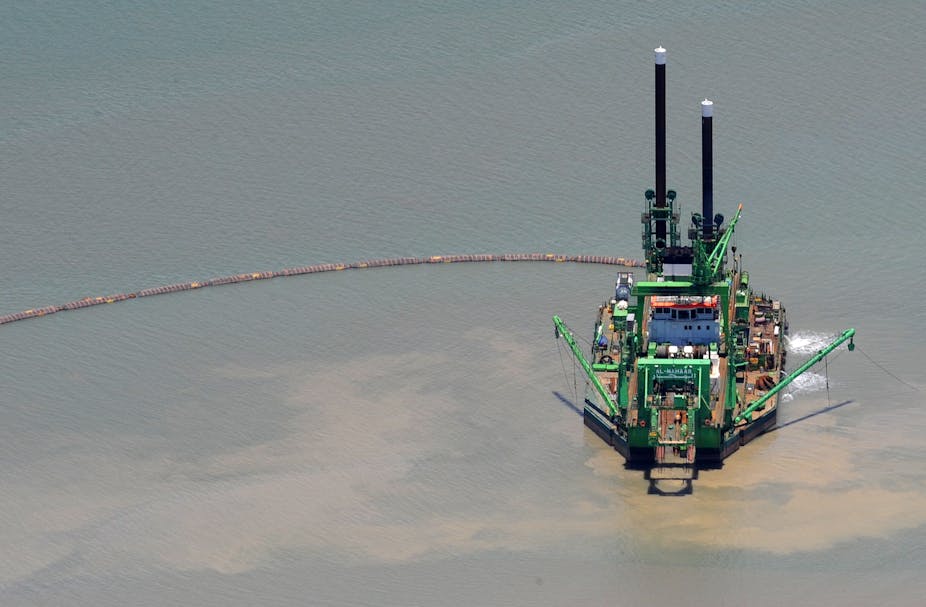To protect and manage environmental treasures like the Great Barrier Reef requires a strong foundation of science, but what should agencies and political leaders do when the science is as widely debated as it has been for dredging and disposal in the Great Barrier Reef?
Over the past 15 months, we have led a process with a panel of experts to provide an independent overview of the current knowledge of the effects of dredging and sediment disposal in the Great Barrier Reef World Heritage Area. Our panel included a very diverse range of expertise and experience, from years in the dredging industry, to physical oceanographers and coral ecologists.
The report, published yesterday, covers the effects of dredging on the physical and chemical environment, flow-on effects on the habitats and biodiversity, cumulative impacts, effects of land-based disposal, and next steps for management.
The report shows, for example, that although direct effects are localised, dredging and disposal may have been making significant contributions to suspended sediments in inshore waters of the Great Barrier Reef.
Given the complexity of the issue, the report can’t provide conclusive answers to all of the questions reef managers face, but it does provide a comprehensive and balanced interpretation of the available evidence. By clearly distinguishing what is known (and agreed by the experts), what is definitively not known, and what is uncertain (that is, still debated by the experts), the report not only provides a clearer way forward for managers, but clearly identifies the knowledge gaps we still need to address.
So what does the report tell us? It says that dredging and sediment disposal can change the physical and chemical environment, and thus affect the biological values of the Great Barrier Reef World Heritage Area. But these effects will differ between locations, and also be influenced by the different types and extents of dredging and sediment disposal.
Direct removal by excavation, and burial during disposal, only affect relatively small areas, although within those areas the effects are obviously severe. Dredging and disposal don’t occur on coral reefs within the Great Barrier Reef area.
Release of fine sediment is the greatest concern
Both dredging and marine disposal create significant plumes of suspended sediment, causing increased cloudiness in the water and reducing the light available to marine organisms.
Importantly, the report concludes that both disposed sediments and dispersed sediments from dredge plumes have the potential to be re-suspended and transported by waves and ocean currents, and to contribute to the long-term, chronic increase in fine suspended sediment concentrations in the inshore Great Barrier Reef.
The extent to which this occurs and affects marine life was not agreed by the expert panel. In particular, the panellists had differing views on whether sediment from dredging was significant compared with background levels of resuspension and inputs of fine sediments in river run-off from catchments. However, calculations suggest that previous large dredging operations had potentially very significant effects.
Most experts do agree that increased levels of fine sediments, and associated nutrients, are, along with climate change, seriously affecting the long-term health of the Great Barrier Reef. Understanding dredging in the context of inshore sediment dynamics is a serious gap in our knowledge.
In general, dredged material from near the Great Barrier Reef has few chemical contaminants, and there are robust management procedures to avoid disposal of such material at sea.
Different habitats, differing effects
The report breaks down and summarises the risks to coral reefs, seagrass meadows, mangroves and estuaries, pelagic (open water) and seafloor habitats, along with the risks to fish and other wildlife of conservation concern, such as dugongs, marine turtles and seabirds. These effects will vary greatly with the location, timing and extent of dredging and disposal. But if dredging and disposal have been significantly increasing fine sediments supply, it is possible that long-term impacts on inshore ecosystems have been under-estimated. We know that chronic increases in suspended sediments have been affecting inshore coral reefs and seagrass beds.
What is clear is that the extent of future impacts in the marine environment will be very significantly improved with the impending bans on disposal of capital dredging in the marine environment, recently announced by the federal and Queensland governments. The proposed ban on disposal of capital material in the Marine Park is open for public comment until this Friday 27 March.
Future challenges
Following a ban on disposal of capital material within the marine environment, there remains the challenge of managing the remaining impacts of dredging, including disposal of maintenance dredged sediments in marine environments, and disposal of capital dredging material on land.
The Expert Panel identified a number of potentially serious impacts and challenges involved in disposing of dredge material on land or in reclamation, including loss of coastal habitats, runoff of seawater and fine sediments from dredged material, and potential acid sulphate soils.
Our panel prioritised identifying what we do know about dredging, but also found significant areas of insufficient knowledge. Most of the panel also agreed on the need to follow up our report with a similar analysis of the social, economic, cultural and heritage aspects of dredging and sediment disposal, including the impacts on Indigenous culture and heritage.
Given the complexity of the Great Barrier Reef ecosystem, and the range of expert views, the intention of this process was never to provide a single, conclusive answer. Rather, our report provides a strong foundation for progressing both knowledge and management directions, and it appears it is already doing that.

